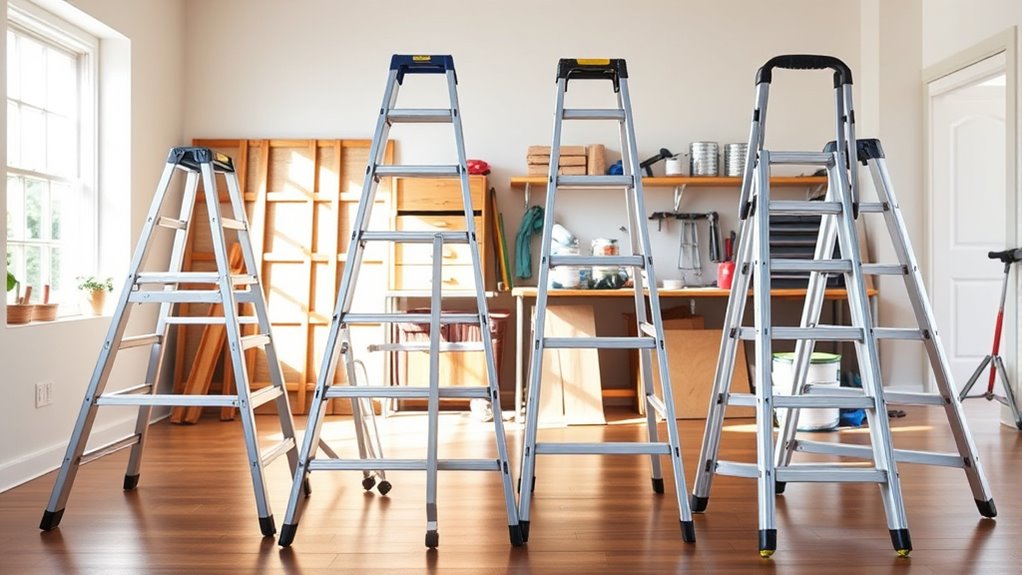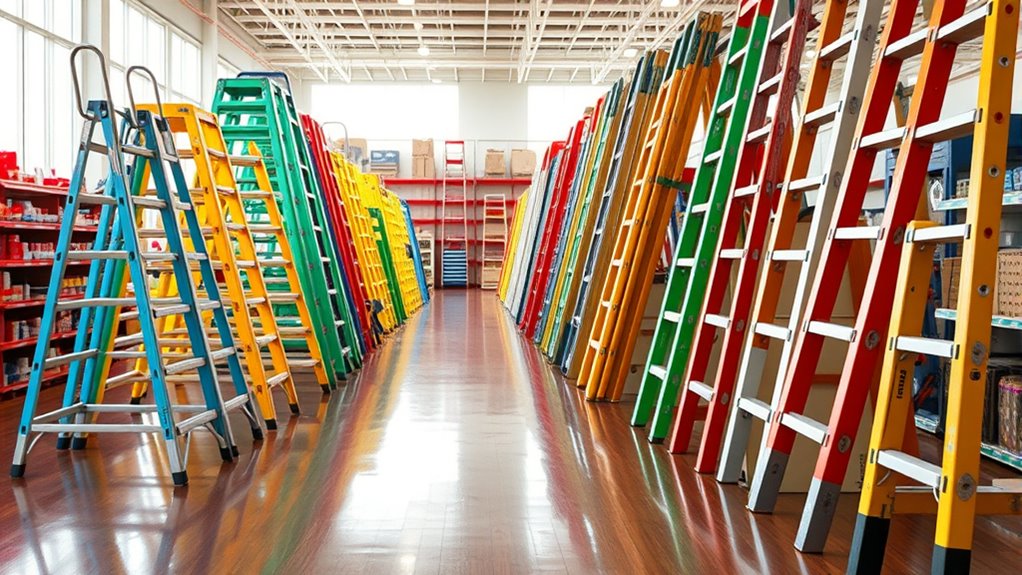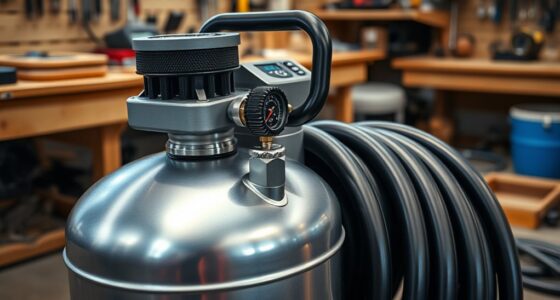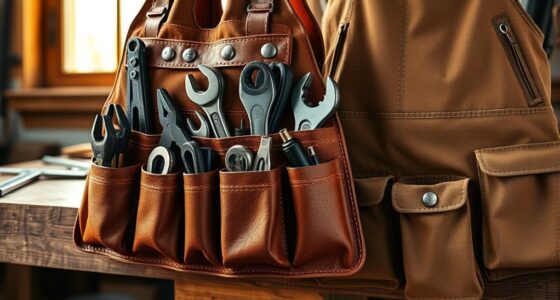To pick the perfect ladder for home projects, focus on safety, material, and design features. Choose a sturdy, well-rated ladder with slip-resistant steps and secure locking mechanisms. Consider aluminum for lightweight tasks or fiberglass for electrical insulation and durability. Step ladders work indoors, while extension ones suit outdoor high-reach jobs. Ensuring proper size, weight capacity, and safety features keeps your work secure. Keep exploring to discover how to match the ideal ladder to your specific needs.
Key Takeaways
- Assess the ladder’s weight capacity and size to match your specific home project needs.
- Choose the material based on safety, durability, and environment—fiberglass for electrical insulation, aluminum for lightweight use.
- Opt for the appropriate type, such as step ladders for indoor tasks and extension ladders for outdoor or high-reach projects.
- Ensure the ladder has slip-resistant steps, secure locking mechanisms, and sturdy feet for stability on various surfaces.
- Regularly inspect safety features and overall condition before use to maintain safety and reliability.

Choosing the right ladder is vital for safely and efficiently completing your home projects. When selecting a ladder, safety considerations should be your top priority. You want a ladder that feels stable and secure, so always check its weight capacity and make sure it’s rated for your specific needs. A ladder that’s too small or not rated for heavier loads can pose serious risks, increasing the chance of slips or falls. Look for features like slip-resistant steps and sturdy locking mechanisms to enhance safety. It’s also wise to inspect the ladder for any signs of damage or wear before use, such as bent rungs or cracked rails, as these can compromise safety during your project.
Material durability is another vital factor to consider. The material of the ladder influences its strength, weight, and longevity. Aluminum ladders are popular because they’re lightweight, rust-resistant, and easy to maneuver, making them ideal for many household tasks. However, they conduct electricity, so avoid using aluminum ladders around power lines or electrical fixtures. Fiberglass ladders, on the other hand, are heavier but offer excellent durability and electrical insulation. They tend to resist weathering and corrosion better than wooden ladders, which are less common today but can still be suitable for certain tasks. Wooden ladders are sturdy and provide good grip, but they are heavier and more susceptible to rot and insect damage if not properly maintained. Whichever material you choose, make sure it’s well-constructed with quality materials to withstand the demands of your projects.
Additionally, consider the ladder’s design and features that complement safety and durability. Telescoping or multi-position ladders offer versatility, allowing you to adjust height easily for different tasks. Step ladders are convenient for indoor projects, while extension ladders are better for reaching higher outdoor areas. Always check the locking mechanisms to confirm they’re secure and reliable. The presence of non-slip feet on the base adds stability on various surfaces, reducing the risk of accidents. It’s also worth considering the overall weight of the ladder; a lightweight option might be easier to carry and position, but it shouldn’t compromise sturdiness. Protective features, such as reinforced rails and safety locks, further enhance safety during use.
Frequently Asked Questions
What Safety Gear Should I Wear When Using a Ladder?
When using a ladder, you should wear safety gear like gloves, non-slip shoes, and a helmet for protection. Make sure to use ladder accessories such as stabilizers if needed. Prioritize safety training to understand proper ladder use and avoid accidents. Always inspect your ladder before climbing, maintain three points of contact, and avoid overreaching. These precautions help keep you safe during your home projects.
How Do I Store My Ladder Safely When Not in Use?
You should store your ladder in a dry, secure spot to guarantee safe placement and prevent accidents. Find a designated area like a wall-mounted rack or sturdy hooks, keeping it off the ground to avoid damage. Make sure it’s away from high traffic zones and children’s reach. Regularly inspect your ladder for damage before storing, and always secure it properly to prevent it from falling or causing injuries.
Can I Use a Household Ladder for Professional Tasks?
Using a household ladder for professional tasks is like trying to run a marathon in sneakers—it might work temporarily but isn’t ideal. Household ladders often lack the durability and safety features needed for professional use. Consider ladder material, like aluminum for lightweight ease or fiberglass for electrical safety. For serious jobs, investing in a professional-grade ladder guarantees safety, stability, and compliance, preventing accidents and saving you money in the long run.
What Is the Maximum Weight Capacity of Most Ladders?
Most ladders have a maximum load capacity of 200 to 375 pounds, depending on their ladder weight limits. Always check the ladder’s label to find its specific weight capacity, especially if you’re using it for professional tasks. Picking a ladder with a higher maximum load capacity guarantees safety and stability. Remember, exceeding the ladder’s weight limits can lead to accidents, so always choose one that comfortably supports your weight plus tools.
How Often Should I Inspect My Ladder for Damage?
Have you checked your ladder recently? Regular ladder maintenance is essential for damage prevention and safety. You should inspect your ladder before each use and at least once a month if you use it frequently. Look for cracks, bent rungs, or loose hardware. Promptly address any damage to keep your ladder in top condition. How well do you know your ladder’s condition? Staying vigilant helps prevent accidents and prolongs its lifespan.
Conclusion
Choosing the right ladder makes all the difference in your home projects. Remember, a survey shows that 81% of DIY injuries involve falls from improper ladder use. By selecting the appropriate ladder and following safety tips, you can diminish risks and complete your tasks efficiently. Don’t rush your decision—investing in the right ladder ensures safety and success. With the right tools, you’ll tackle any project confidently and safely.









